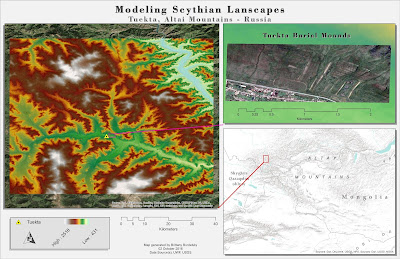The first task was to generate non-sites (though this is not an ideal method as it is not ground truthed data). ArcGIS has a nifty tool that generates random points across your data. The Create Random Points (a Data Management tool) accomplishes that end. Once the points were generated they were merged with the Tuekta mounds identified last week. The attribute table was then populated with the reclassified slope, aspect, and elevation numbers from the secondary coverages.
With the attribute table populated, I ran an OLS linear regression using these sites and 'non-sites.' Turns out the model, as it stands, explains about 74% of variability in the data. (Elevation had the highest coefficient of the three variables.) We also checked the results of the OLS regression against the results of a Spatial Autocorrelation and a Hot Spot Analysis. The results are summarized in the map deliverable. Two data frames display the OLS and Hotspot analyses over a DEM of the study area. The results (a low p-value and a high Z-score confirm the results of the regression - the data is clustered and non-random) of the Spatial Autocorrelation are shown at the bottom of the map. Adding additional variables could improve the predictability of the model, however, these variables are enough to parse the statistics and learn a bit about probing landscape level archaeological data.
 |
| Map deliverable showing the results of both the OLS and hotspot analyses overlaid atop the study area DEM. The Spatial Autocorrelation results are also shown for reference. |


